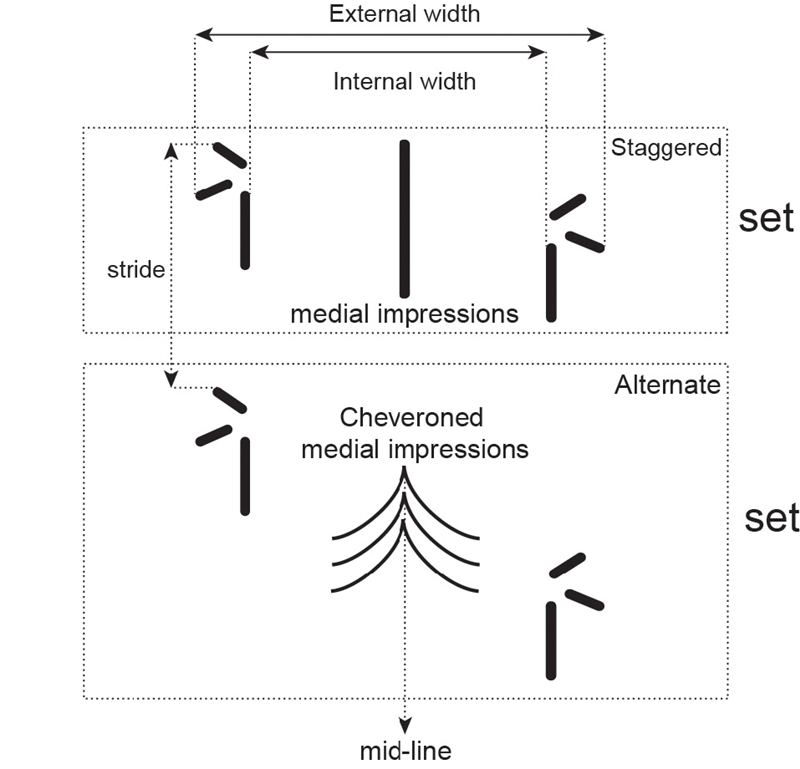
해남 우항리층에서 산출하는 절지동물 생흔화석의 형성자 비교연구
초록
전라남도 해남군 후기백악기 우항리층의 처트질이암층에서 산출하는 다양하고 정교한 절지동물 생흔화석에 대해 보존 특성과 형성자에 대한 비교연구가 이루어졌다. 이 생흔화석의 보존에는 산출된 퇴적층의 퇴적 당시의 특성, 즉 수분에 포화된 세립질 퇴적물의 물성, 비정질 실리카 조성에 기인한 점성, 생흔화석 위에 응회질의 퇴적물이 덮인 특성 등이 영향을 준 것으로 해석된다. 한편 우항리층의 절지동물 보행렬이 형태적으로 다양하게 발견되는 것은 퇴적물이 짧은 시간 동안 공기 중에 노출되면서 수분함량이 달라지며 형성된 것에 기인한 것으로 판단된다. 이러한 점을 고려할 때 생흔형성자는 수서 환경과 육상 환경 모두에서 생존 가능하며 버로우를 하는 생물로 여겨진다. 이를 바탕으로 우항리층 절지동물 생흔화석과 전 세계에서 보고된 절지동물 생흔화석을 비교하여 생흔형성자 후보로 거미류, 갑각류, 곤충류를 선정하였다. 각각의 분류군에 대하여 생흔의 형태, 서식환경, 행동유형 등의 측면에서 비교 분석하였으며, 이와 함께 기존의 한반도 백악기의 절지동물 화석군을 대상으로 비교 분석하였다. 결론적으로 해남 우항리층의 절지동물 생흔화석은 거미류나 갑각류보다 곤충류 가운데 잠자리 유충에 의하여 생성되었을 가능성이 큰 것으로 해석된다.
Abstract
In this paper, we conduct a comparative study on preservation characteristics and tracemaker of arthropod trace fossils found in the cherty mudstone bed of the Late Cretaceous Uhangri Formation, Haenam, Jeollanam-do Province of Korea in various and delicate forms. This preservation of trace fossils could be attributed to characteristics of the substrate; the saturated and stable condition of the fine-grained substrate; the viscosity of the substrate derived from precipitated amorphous silica; and the overlaying tuffaceous sediments. Also, the morphological variation of the trackways indicates that the brief exposure of the substrate to the subaerial environment brings the fluctuation of moisture conditions. It is interpreted that the tracemaker could have survived both the aquatic and subaqueous environments with burrowing. Therefore, we selected the arachnids, crustaceans, and insects as candidates for the tracemaker of the Uhangri Formation, comparing the trackway of arthropods reported in the world. Herein, we conduct on a comparative study of the morphology of trace fossils, habitat environment, and behavior patterns of with each candidate, and compare with arthropod fossils reported in the Cretaceous in the Korean Peninsula. Consequently, the arthropod trace fossils in the Uhangri Formation could be attributed to insects, especially Odonata larvae, rather than arachnids, or crustaceans.
Keywords:
Uhangri Formation, cherty mudstone bed, arthropod trace fossil, tracemaker, Odonata larvae키워드:
우항리층, 처트질이암층, 절지동물 생흔화석, 생흔형성자, 잠자리 유충1. 서 언
전라남도 해남군에 있는 우항리층은 그 동안 다양한 종류의 척추동물 생흔화석 연구로 많은 관심을 받아왔다. 대규모의 공룡 발자국 화석(Hwang, 2001; Lee and Huh, 2002, Hwang et al., 2008)을 비롯하여 세계에서 가장 큰 익룡 발자국 화석인 Haenamichnus uhangriensis가 보고된 바 있고(Lockley et al., 1997; Hwang et al., 2002) 물갈퀴 새 발자국화석인 Uhangrichnus chuni와 Hwangsanipes choughi도 같은 층준에서 보고되었다(Yang et al., 1995). 이러한 다양한 척추동물의 생흔화석 연구와 비교하면 우항리층 무척추동물 생흔화석에 관한 연구는 비교적 미비하다. Huh et al. (1998)은 우항리층에서 무척추동물 생흔화석인 Planolites, Skolithos, Thalassinoides 등과 함께 이 연구에서 다루는 절지동물 보행흔 화석을 보고하였으며, Minter et al. (2012)은 이 절지동물 보행흔 화석을 Lithographus hieroglypichus로 동정하였고 일반적인 L. hieroglypichus가 유시아강(pterygota)에 의해 만들어 졌다는 이유로 해남의 보행렬 화석 또한 유시아강의 곤충에 의해 만들어졌을 것으로 주장하였다. 이 연구에서는 절지동물의 보행렬 화석과 함께 동일한 생흔형성자에 의해 만들어졌을 것으로 보이는 다른 흔적화석들과 전 세계에서 보고된 절지동물 생흔화석, 기존에 한반도 백악기 퇴적층에서 보고된 절지동물 화석군과 비교 분석하여 우항리층 절지동물 생흔형성자의 후보에 대해 고찰해보고자 한다.
2. 지질개요
절지동물 생흔화석이 발견되는 전라남도 해남군 우항리층은 한반도 서남부에 있는 해남분지에 속해있다(그림 1a). 해남분지는 한반도 남부의 좌수향 주향이동 단층계에 의해 형성된 여러 인리형 퇴적분지 중 하나이며(Chun and Chough, 1992) 하부로부터 안산암질응회암, 우항리층, 황산응회암, 그리고 진도유문암으로 이루어져 있다(Lee and Lee, 1976). 그중 두께 약 400 m의 우항리층은 주로 역암, 사암, 처트질이암, 그리고 흑색 셰일로 대부분 이루어지며 화산쇄설물과 함께 하성-호성 환경에서 퇴적된 층으로 해석된다(Chun and Chough, 1995). 우항리층의 연대는 상부와 하부의 황산응회암과 안산암질응회암의 K-Ar 연대측정 결과 82.8±1.7 Ma와 94.1±2 Ma로 측정되었으며(Moon et al., 1990) 발자국화석이 산출되는 층의 하부와 상부의 응회암의 Rb-Sr 전암 연대 측정 결과, 하부의 라필리응회암은 96.0±2.5 Ma, 상부의 규질 응회암은 81.0±2.0 Ma로 보고되었다(Kim et al., 2003).
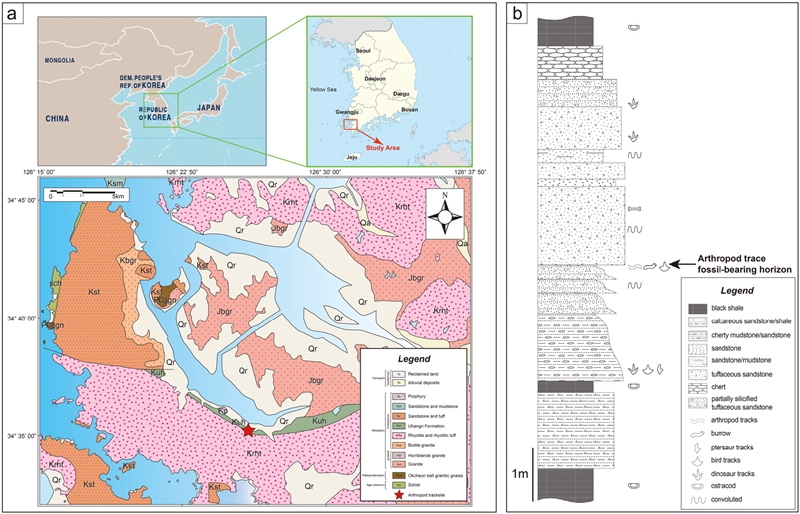
(a) Locality and geological map of the study area. (b) Columnar section of the trace fossil-bearing horizon (modified from Hwang et al., 2002).
절지동물 생흔화석이 발견되는 처트질이암층은 화산 기원의 실리카가 높은 pH에 의해 용해된 상태에서 갑작스러운 담수의 유입으로 인해 침전되어 만들어진 화산물질 기원의 처트로 알려졌다(Chun and Chough, 1995; Chough et al., 1996). 절지동물 생흔화석은 우항리층의 여러 처트질이암층 중에서 한 층준에서만 발견된다(그림 1b). 이 층에서는 곳곳에서 층내변형구조와 처트돌기구조가 관찰되는데 이는 겔 상태의 실리카 침전물이 미고화 상태일 때 만들어지는 것으로 보인다(Chun and Chough, 1995). 이 층준에서 발견되는 시네레시스 균열(syneresis crack)은 교질상태의 점토가 염분이 바뀌었을 때 구성하고 있던 조직이 붕괴하고 수축하며 만들어지는 구조로 알려졌기 때문에(White, 1961; Burst, 1965) 당시 호수환경이 갑작스러운 염분의 변화가 심했던 환경이었다는 사실을 뒷받침한다. 절지동물 생흔화석이 발견되는 처트질이암층은 하부로부터 점이적으로 상향세립화 되는 경우를 보이며 그 위는 얇은 응회암으로 덮여있다.
3. 연구대상 및 방법
이 연구에서 사용된 절지동물 생흔화석은 전라남도 해남군 황산면 우항리에 위치한 천연기념물 제394호 해남 우항리 공룡·익룡·새 발자국화석 산지 내부의 해남공룡박물관 제1보호각 인근(34° 59’ 05”N, 126° 43’ 79”E)에서부터 금호방조제를 따라 북서서-남동동 방향으로 약 4 km에 걸쳐서 노출되어 있다(그림 2). 보행렬, 버로우(burrow), 휴식흔(resting trace) 화석들은 모두 처트질이암층의 최상부 표면에 위치하고, 단일 층준에서만 매우 밀도 높고 정교한 형태로 발견되며(그림 3a-g) 새 발자국 화석이 같은 층준에서 산출한다. 이 중 이번 연구에서는 해남공룡박물관 제1보호각 앞에 노출되어있는 보행렬 46개와 버로우 23개, 휴식흔 1개, 해남공룡박물관에 전시되어있는 표본 1개를 대상으로 하였다.
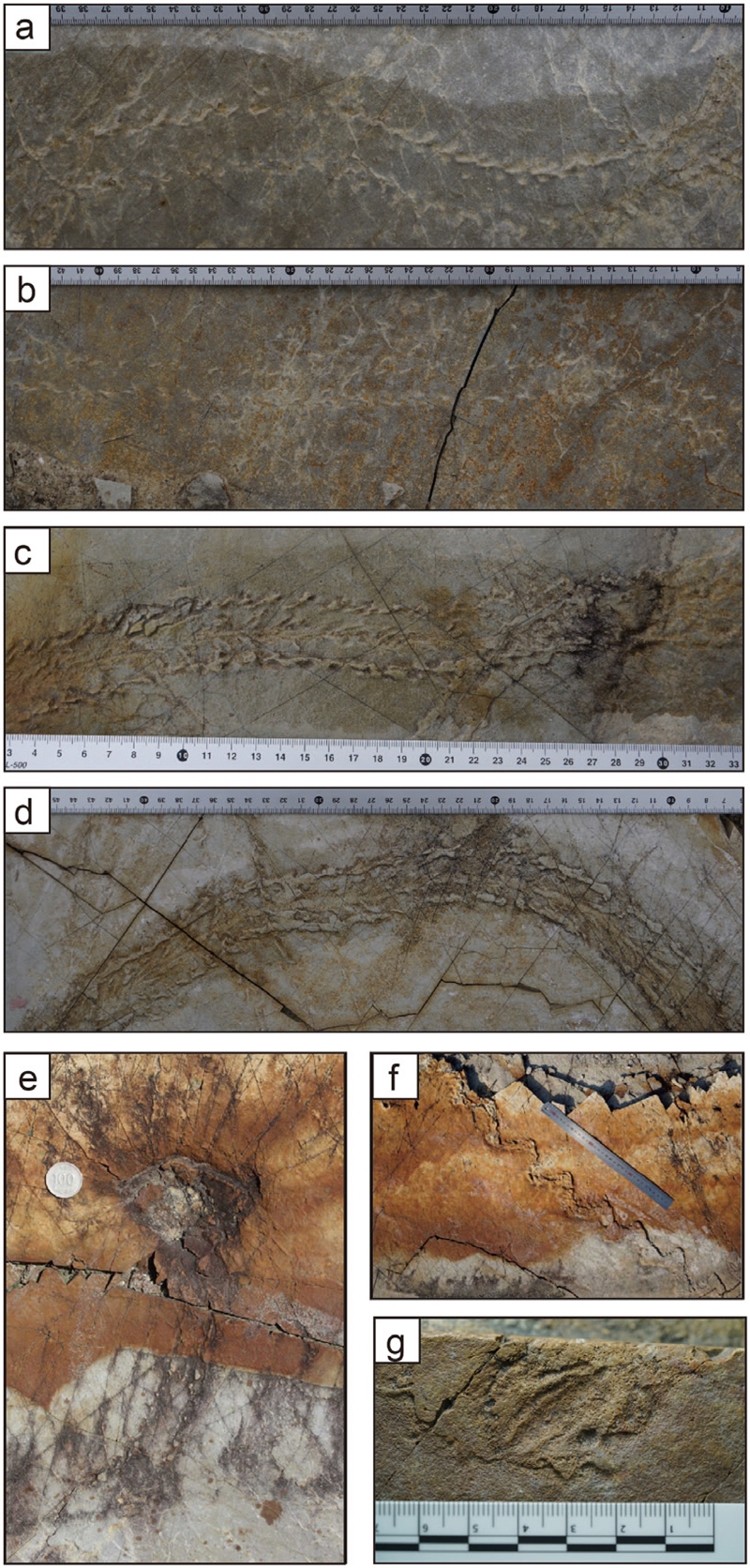
Various types of arthropod trace fossils in the Uhangri Formation. (a-b) Trackway with separated footprints (hyporelief and epirelief) without medial impressions. (c) Trackway with separated footprints (hyporelief and epirelief) and medial impressions. (d) Trackway with merged footprints (epirelief) and medial impressions. (e) Burrow connected with trackway. (f) Sinusoidal shape trackway. (g) Resting trace.
절지동물 생흔화석은 천연기념물 제394호 해남 우항리 공룡·익룡·새 발자국화석 산지에 포함되어 보호되고 있는 관계로 현장에서 촬영 및 기재하였다. 사진 촬영에는 디지털카메라 SONY A7 Mark III와 Canon 100D를 이용하였으며 Adobe Photoshop CC 2019, Adobe Illustrator CC 2019를 이용하여 디지털 자료로 변환하였다. 생흔화석 기재에 사용한 용어들은 Trewin (1994), Braddy (2001), Minter et al. (2007a)을 참고하였다(그림 4). 야외 조사는 2014년 12월부터 2020년 1월까지 주기적으로 시행되었으며 기존에 발견된 표본 이외에 2014년 10월부터 2015년 5월까지 시행된 해남군 공룡화석지 야외노출화석 발굴 및 보존 학술연구 사업으로 추가 발굴되거나 보행렬이 연장된 화석도 연구대상에 포함하였다.
4. 기재
4.1 보행렬
기재: 우항리층의 절지동물 보행흔 화석은 각각의 족흔이 양각(hyporelief) 또는 음각(epirelief)으로 보존되어 있다(그림 5a-d). 일부 보행렬에서는 족흔이 양각으로만 이루어지며 융합된(merged) 형태로 나타난다(그림 5e, 5f). 각각의 족흔들은 서로 다른 방향을 향하고 있으며 세 쌍의 족흔이 한 세트(set)를 이루고 있다. 족흔은 중앙선(mid-line)을 중심으로 서로 비대칭으로 엇갈리거나(staggered) 번갈아가며(alternating) 나타난다. 일반적으로 인상이 선명하게 보존된 보행렬은 세 쌍의 족흔이 잘 관찰되나(그림 5a) 상대적으로 인상이 깊지 않은 보행렬의 경우 족흔이 한 쌍 또는 두 쌍의 세트만으로 이루어진다(그림 3b). 일부 보행렬에는 셰브론 무늬의 중앙의 끌린 흔적(medial impressions)이 관찰된다(그림 5c-f). 외폭의 범위는 22-42 mm이며 상대적으로 외폭이 좁을수록 인상이 선명하지 못하고 족흔이 한 쌍 또는 두 쌍으로 불완전하게 남으며 외폭이 넓을수록 족흔이 선명하게 관찰되는 경향이 있다. 각각의 보행렬은 족흔 세트의 개수, 중앙의 끌린 흔적, 족흔이 서로 융합되었는지에 따라 다양한 형태적 변이를 보이는데 일부 보행렬은 진행 방향에 따라 그 형태가 전이적으로 변화하기도 한다.

Morphological variation of arthropod trackways in the Uhangri Formation. (a-b) Trackway of separate footprints (hyporelief and epirelief) without medial impressions. (c-d) Trackway of separate footprints (hyporelief and epirelief) and medial impressions and intersecting trackway of merged footprints. (e-f) Trackway of separate footprints (epirelief) and medial impressions and intersecting trackways with separated footprints. Abbreviations: sf = separate footprint; mf = merged footprint; cmi = chevroned medial impression. All scale bars are 20 mm.
토의: 우항리층의 절지동물 보행렬은 Huh et al. (1998)에 의하여 최초로 보고되었지만 정확한 동정 없이 절지동물 보행흔으로 기재하였으며 이후 Minter et al. (2012)는 이 보행렬을 Lithographus hieroglyphicus로 동정하고 유시아강의 곤충에 의해 만들어졌을 것으로 추정하였다. Lithographus는 Hitchcock (1858)에 의해 처음 명명되었으며 작은 갑각류나 곤충의 보행흔이거나 해초에 의한 흔적일 것으로 추정하였다. 그러나 서로 다른 방향을 이루는 세 쌍의 족흔이 세트를 이루며 반복된다는 점(Minter and Braddy, 2009)과 현생생흔학적 연구로 바퀴벌레와 같은 종류의 곤충이 이와 유사한 생흔을 만든다는 점(Davis et al., 2007)을 바탕으로 유시아강(pterygota)의 곤충의 보행렬일 것으로 해석되었다 . 그러나 Schmerge et al. (2013)는 거미강에 속하는 식초전갈(Thelyphonidae)을 이용한 현생생흔연구를 통해 유시아강의 곤충이 아닌 다른 절지동물도 세 쌍의 부속지를 통해 보행한다면 Lithographus를 만들 수 있음을 주장하였기 때문에 생흔형성자 후보군에 대하여 더욱 체계적인 접근이 필요하다.
우항리층의 L. hieroglyphicus는 정교하고 다양한 형태로 관찰된다. 이러한 정교하게 보존된 보행렬 화석은 퇴적물이 안정적이며 단단한 세립질의 퇴적물이 물속에 있거나 물 밖에 노출되더라도 어느 정도 수분을 함유하고 있을 때 만들어지는 것으로 알려졌다(Minter et al., 2007b). 우항리층의 보행렬 화석은 외폭에 비하여 보폭이 짧은 경향을 보이는데 이는 생성 당시 화학적으로 침전된 비정형의 실리카가 가지고 있는 점성이 높은 퇴적물의 특성 때문으로 해석되었고(Minter et al., 2012). 이러한 퇴적물의 특징이 생흔화석의 보존에 영향을 미쳤을 것으로 생각된다.
몇몇 보행렬은 진행에 따라 형태가 전이적으로 변하기도 하고 서로 다른 형태의 보행렬이 겹쳐 발견되기도 한다(그림 5e). 보행렬 화석이 발견된 처트질이암층의 최상부를 응회질의 퇴적물이 바로 덮고 있어 퇴적물의 깊이에 따른 변이(undertrack)에 의해 만들어졌을 가능성을 배제할 경우 절지동물 보행렬의 형태적 다양성에 영향을 미칠 수 있는 주요 요인으로는 퇴적물의 입자 크기와 수분함량을 고려해 볼 수 있다(Davis et al., 2007). 하지만 우항리층의 보행렬에는 화학적 침전으로 인하여 최상부의 입자크기가 일정하고 서로 다른 형태의 보행흔이 교차하는 것으로 보아 퇴적물의 입자크기 때문은 아닌 것으로 보이며 서로 다른 독립적인 보행렬이 일정한 방향을 따라 같은 형태로 변화하는 형태가 관찰되는 것을 보아 해남 우항리층의 절지동물 보행렬의 형태적 변이는 퇴적물의 수분 함량에 기인한 것으로 보인다. 마지막으로 보행렬이 새 발자국과 함께 산출된다는 점, 수중에서의 염분 차에 의해 만들어지는 시네레시스 균열이 관찰되지만 건열은 관찰되지 않는다는 점을 고려했을 때 우항리층의 절지동물 보행흔은 퇴적물이 잠시 물 밖으로 노출된 후 만들어 지고 건열이 만들어지기 전 응회질의 퇴적물으로 덮여서 보존된 것으로 보인다.
4.2 버로우(Burrow)
기재: 우항리층의 버로우(burrow)는 절지동물 보행흔과 같은 층준에서 발견되며 원형 또는 타원형의 형태로 관찰된다(그림 6a-d). 많은 버로우가 보행렬과 연결되어 절지동물이 들어가거나 나온 것으로 보이며 버로우 중심부에는 하위층의 이암과 사암이 교란되어 올라와 있으며 그 주변부는 중심을 향해 말려들어 가 있다. 버로우의 단면이 노출된 표본에서 하부수직방향으로 약 11 cm 교란된 양상이 관찰된다(그림 6a).
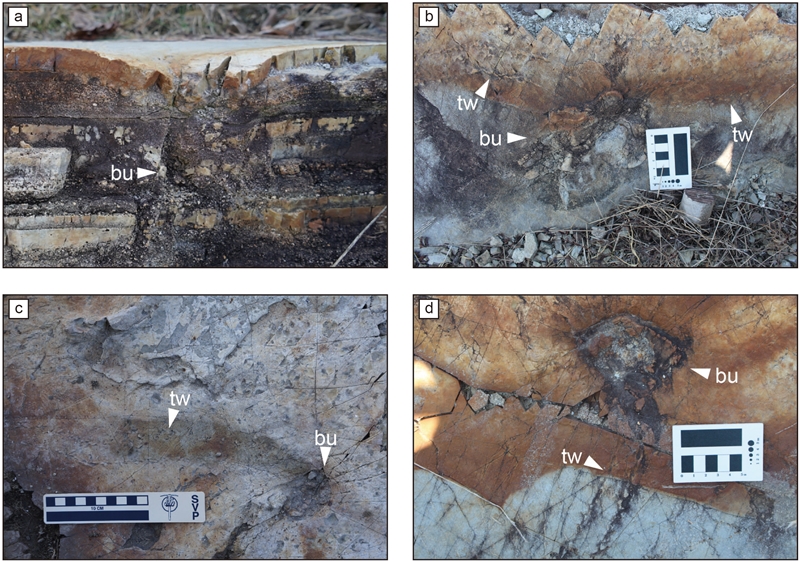
Burrow traces observed in the Uhangri Formation. (a) Vertical section of the burrow. (b) Burrow trace connected with two trackways. (c-d) Burrow connected with a single trackway. Abbreviations: bu = burrow; tw = trackway.
토의: 버로우는 한 개 또는 두 개의 보행렬과 연결되어 있으며 깊지 않은 것을 보아 잠시 몸을 숨기기만 한 것으로 보인다. 또한 중심부를 기준으로 교란된 형태로 보아 퇴적물을 제거해내고 몸을 숨기며 만드는 굴착형(Excavator) (see Wallwork, 1970; Hasiotis, 2000)의 생물이 아닌 자신의 몸을 밀어 넣어 퇴적물 속으로 들어가는 은폐형(Pusher) (see Wallwork, 1970; Hasiotis, 2000) 생물인 것으로 보인다.
4.3 휴식흔(Resting trace)
기재: 절지동물 휴식흔(resting trace)으로 추정되는 흔적화석이 보행렬과 매우 인접한 곳에서 발견되며 너비 28 mm, 폭 35 mm의 흔적으로 이루어진 단일 표본이 독립적으로 관찰된다(그림 7a, 7b). 상부는 절단되어 불완전한 모습으로 보존되 있으며 전체적으로 중심을 기준으로 좌우대칭의 형태이다. 하단에는 장축 22 mm, 단축 6 mm의 중심부 타원형 인상(medial oval imprint)이 단축과 평행인 방향으로 선형의 인상이 희미하게 남아있는 형태로 보존되어 있으며 양 측면으로 같은 굴곡을 가지는 곡형의 흔적이 함께 발견된다. 상단에는 중심부 원형 인상(medial circular imprint)이 지름 3 mm 크기로 존재하며 측면에는 선형의 인상이 좌측에 한 개, 우측에 세 개가 관찰된다.

Resting trace observed in the Uhangri Formation. (a) Photograph of a slab on which resting trace is preserved. (b) Interpretive drawing of view (a). Abbreviations: mc = medial circular imprint; mo = medial oval imprint; la = left appendage; ra = right appendage. All scale bars are 10 mm.
토의: 휴식흔의 너비와 보행흔의 내폭이 유사한 점을 고려하였을 때 보행흔을 남긴 개체와 동일한 개체에 의한 것으로 추정된다. 휴식흔은 상단이 유실되어 단순한 휴식흔인지 생흔형성자가 죽으면서 남긴 흔적인지는 파악하기 어렵다. 중심부 타원형 인상에서 관찰되는 선형의 인상은 체절의 흔적으로 보이며 좌우의 곡형 인상은 아마도 생흔형성자가 자신의 몸을 숨기기 위해 양쪽으로 퇴적물을 밀어내면서 만든 흔적일 것으로 보인다. 이러한 움직임은 현생의 절지동물 중에서도 자신의 몸을 은폐하기 위해 배를 좌우로 움직여 퇴적물 속으로 숨는 행동에서도 관찰 할 수 있다. 양 측면의 선형의 인상들은 생흔형성자의 부속지 흔적인 것으로 보인다.
5. 생흔형성자 비교연구
생흔화석의 형성자를 추정하는 과정에서 여러 조건과 한계에 관한 연구가 수행되어왔다. Fortey and Seilacher (1997)는 생흔형성자를 추정하는 데 있어서 여섯 가지의 특정한 기준을 제시하였다: (1) 현장에서의 밀접한 관계(close association in the field); (2) 층서 범위(concurrent stratigraphic range); (3) 후보 선택의 최소화(a minimal choice of candidates available that could have made the trace); (4) 크기 범위(consistent size range between trace fossil population and that of the maker); (5) 생물지리적 범위(consistent biogeographic ranges for both). 또한, 토양에서 관찰되는 육성생흔이 그 생흔형성자의 (1) 생물의 크기(body size); (2) 어떤 퇴적물에 서식하는지(presence in the media); (3) 행동 유형(type of activity); (4) 퇴적물에 미치는 영향(effects on the media); (6) 선호하는 서식환경(habitat preference)을 지시할 수 있다는 연구가 수행되어 왔으며(Wallwork, 1970; Hasiotis, 2000, 2004) 이러한 조건은 수서 환경에도 마찬가지로 적용될 수 있다(Hasiotis, 2007). 이러한 점을 고려하여 전 세계에서 발견되는 절지동물 보행렬 화석과 우항리층의 절지동물 보행렬 화석을 비교하여 생흔형성자가 될 수 있을만한 분류군을 정리한 후 생흔형성자의 서식환경, 행동양식, 기존의 한반도 백악기 퇴적층에서 보고된 절지동물 화석 분류군과 비교를 실시하였다.
5.1 거미류(Arachnids)
거미는 화석화되기 매우 어려워 호박 속에 보존된 거미가 아닌 암석 속에 보존된 거미 화석은 매우 드물지만, 한반도 전기백악기 진주층에서 거미 화석이 보고된 바 있다(Selden et al., 2012; Park et al., 2019). 일반적으로 거미류의 생흔화석은 전갈류의 생흔화석과 매우 유사한 특징을 가지며(Sadler, 1993) 고환경적인 요소를 통하여 구분한다. 두 분류의 보행렬 화석에 대하여 현생생흔학 연구를 통해 보행렬에 관한 연구가 수행되었고(Brady, 1939; Sadler, 1993; Davis et al., 2007) 이에 따르면 기존의 거미 또는 전갈이 만든 보행렬일 것으로 보고된 Paleohelcura (그림 8a-d)와 Octopodichnus (그림 8e-j) 사이의 전이적인 형태를 보이는 보행렬 화석이 별개의 생흔종으로 보고되어있을 가능성도 있는 것으로 보인다(Minter and Braddy, 2009). 이는 거미와 전갈 모두 여덟 개의 다리를 이용하여 보행한다는 특징 때문으로 보이긴 하나 일부 현생생흔학적 연구와 보고된 보행렬 화석에 의하면 퇴적물의 상태에 따라 네 개의 족흔이 하나의 세트를 이루는 Paleohelcura tridactyla (그림 8c, 8d)와 세 개의 족흔이 하나의 세트를 이루는 Paleohelcura dunbari (그림 8a, 8b)가 전이적으로 나오는 경우가 보고되었다(Sadler, 1993). 또한, 거미강 미갈목에 속하는 식초전갈(Thelyphonidae)은 곤충과 마찬가지로 세 쌍의 부속지를 이용해 보행하기 때문에 Lithographus와 유사한 형태의 보행렬을 만들며 기존에 Lithographus로 분류된 생흔들에 식초전갈의 보행흔이 잘못 편입되어 있을 수도 있다고 주장하였다(Schmerge et al., 2013). 따라서 세 개의 족흔이 하나의 세트를 이루더라도 거미나 전갈에 의한 생흔일 가능성도 있다.
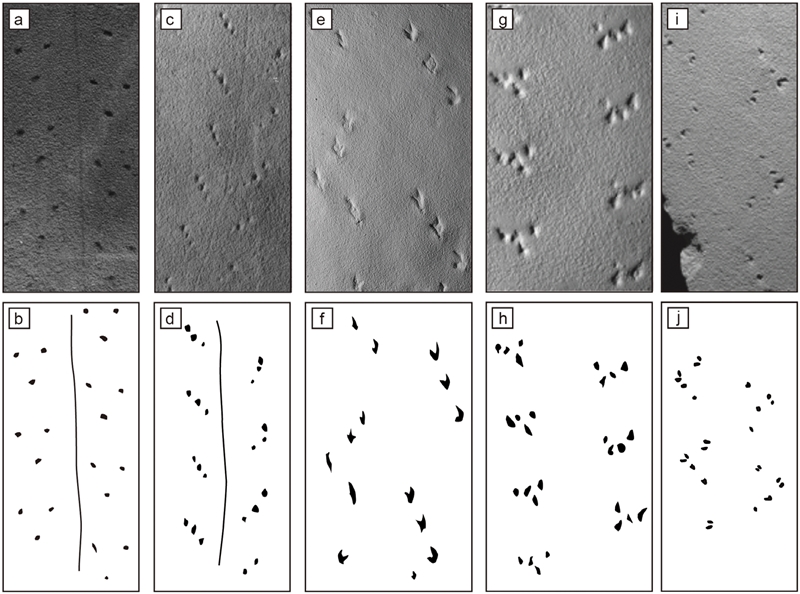
Trackways of the arachnids. (a) Paleohelcura dunbari (modified from Sadler, 1993). (b) Interpretive drawing of P. dunbari. (c) Paleohelcura tridactyla (modified from Minter and Braddy, 2009). (d) Interpretive drawing of P. tridactyla. (e) Octopodichnus didactylus (modified from Minter and Braddy, 2009) (f) Interpretive drawing of O. didactylus. (g) Octopodichnus raymondi (modified from Sadler, 1993). (h) Interpretive drawing of O. raymondi. (i) Octopodichnus minor (modified from Sadler, 1993). (j) Interpretive drawing of O. minor.
해남 우항리층의 절지동물 생흔화석이 Lithographus로 동정 되어있고 거미강 식초전갈의 최초의 화석 기록이 후기 석탄기인 만큼(Tetlie and Dunlop, 2008) 생흔형성자가 식초전갈을 포함한 거미류일 가능성도 고려하였다. Schmerge et al. (2013) 은 현생생흔연구를 통해 퇴적물의 상태에 따른 식초전갈의 보행렬에 관한 연구를 수행하였는데 형태적으로는 유시아강의 곤충이 만든 Lithographus와 매우 유사하지만, 해남의 절지동물 보행렬에서 관찰되는 중앙의 끌린 흔적(medial impressions)이 어떠한 퇴적물 조건에서도 관찰되지 않았다. 또한, 현생의 식초전갈은 습한 토양에서 깊은 굴을 파서 서식하는 반면(Dindal, 1990) 우항리층 절지동물 생흔화석이 발견되는 퇴적조건은 이와 거리가 멀고 버로우의 구조도 식초전갈이 만든 깊고 분절되는 형태의 버로우(Hembree, 2013)와는 거리가 멀다. 이러한 선호하는 환경에 대한 차이점들을 고려할 때 거미류는 우항리층 절지동물 생흔형성자와는 거리가 먼 것으로 보인다.
5.2 갑각류(Crustaceans)
갑각류는 현존하는 생물 중 가장 다양한 종을 가진 분류군 중 하나이지만 한반도 백악기의 퇴적층은 육성층에 한정되어 그동안 보고된 백악기 갑각류 화석은 개갑류(Choi, 1990), 개형충(Paik et al., 1988; Choi and Huh, 2016; Choi et al., 2017, 2018), 등각류(Park et al., 2012)에 한정되었다.
갑각류에 의해 만들어진 보행흔에 관한 연구는 주로 십각류(Decapoda)와 등각류(Isopoda)에 집중되어왔다. Walker et al. (2003)은 소라게(hermit crab)의 현생생흔연구을 통해 Coenobichnus currani(그림 9c, 9d)를 소라게에 의해 만들어진 보행렬로 명명하였고 Pirrie et al. (2004)는 Foersterichnus rossensis(그림 9a, 9b)가 십각류에 의해 만들어진 보행렬이라고 주장하였다. 또한, Fairchild and Hasiotis (2011)는 가재를 통한 현생생흔학적인 연구를 통해 현생 가재의 보행흔이 Protichnites, Kouphichnium, Coenobichnus currani, Undichna bina와 유사하다고 주장하였다. 등각류에 의해 생성되었을 것으로 생각되는 보행렬 화석은 다양한 지역과 층에서 보고되었다(Bandel, 1967; Gibbard and Derimanis, 1978; Gaillard et al., 2005). 그중 프랑스 상부 쥐라기층에서 발견된 중앙의 끌린 흔적이 없이 두 줄의 대칭적인 족흔이 반복되는 Pterichnus isopodicus (그림 9e, 9f)는 우항리층의 생흔화석과 같이 보행렬의 다양한 형태 변이가 나타난다. 뿐만 아니라 보행렬 끝에서 등각류의 체화석이 함께 발견되어 생흔형성자가 명확하게 보고되었다(Gaillard et al., 2005).
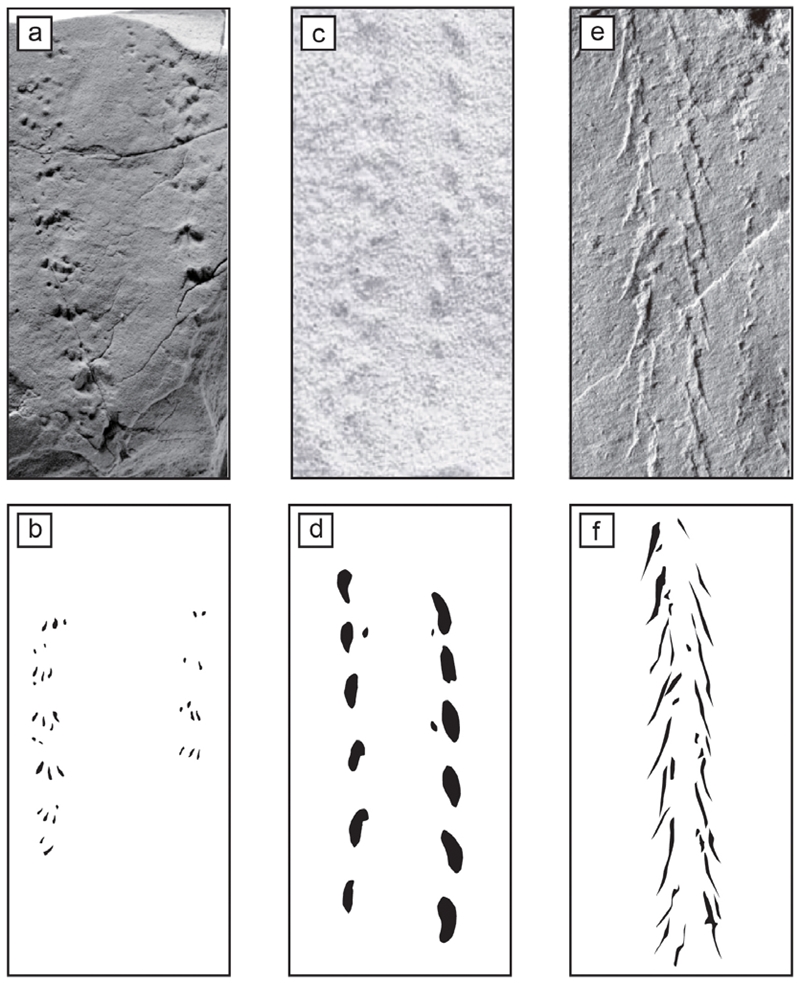
Trackways of the crustaceans. (a) Foersterichnus rossensis (modified from Pirrie et al., 2004). (b) Interpretive drawing of F. rossensis. (c) Coenobichnus currani (modified from Walker et al., 2003). (d) Interpretive drawing of C. currani. (e) Pterichnus isopodicus (modified from Gaillard et al., 2005). (f) Interpretive drawing of P. isopodicus.
우항리층의 절지동물 생흔형성자의 경우 십각류와 생태적으로 유사한 점이 있지만, 한반도에서 백악기 담수 게 화석이 보고된 바가 없다. 등각류 또한 수중에서 저서 생활을 하기도 하며 수면 위로 올라와 주변부에서 활동하기도 하고 버로우를 만든다는 점에서 생태적으로 우항리층 생흔형성자와 유사점이 있다. 또한, 등각류 화석이 한반도 중생대 퇴적층에서 보고된 바 있다(Park et al., 2012). 우항리층 절지동물 보행렬의 여러 형태 중 Pterichnus isopodicus와(그림 9e, 9f) 유사한 형태의 보행렬이 발견되지만(그림 3b) P. isopodicus의 경우 모든 형태의 보행렬에서 중앙의 끌린 흔적이 나타나지 않고 우항리층의 보행렬과 달리 긴 선형의 족흔을 남기는 경우가 많다. 따라서 보행렬의 형태적 다양성이 퇴적물의 수분 조건에서 기인할 수 있다는 점을 고려하면 등각류가 남긴 보행렬의 형태변화와 우항리층 생흔형성자가 남긴 보행렬의 형태변화 중 일부가 비슷한 형태로 만들어 지기 때문으로 보이며 등각류가 아닌 다른 형태의 우항리층 보행렬을 만든 개체와 동일하나 크기만 작은 개체일 가능성이 높아 보이지만 이 부분에 대하여는 추가적인 연구가 필요하다.
5.3 곤충류
한반도의 백악기 퇴적층에서 그동안 여러 분류군의 곤충화석이 보고된 바 있다. 전기백악기 진주층에서 집게벌레(Engel et al., 2002), 약대벌레(Engel et al., 2006), 바퀴류(Baek and Yang, 2004), 잠자리 유충 및 성충(Ueda et al., 2005; Nam and Kim, 2016), 수서딱정벌레 유충 및 성충(Park et al., 2013), 방아벌레(Sohn et al., 2019), 파리 (Khramov et al., 2019)가 발견된 바 있으며 함평분지에서 딱정벌레(Huh and Chung, 2009)가 발견되었다. 북한지역의 경우 백악계 신의주통에서 하루살이 유충, 바퀴벌레, 잠자리 유충과 성충(Kim et al., 1992), 벌(Jon et al., 2019), 메뚜기(So et al., 2020), 거품벌레(Jon et al., 2020)가 발견되었다고 알려졌다.
생흔학적인 측면에서 많은 육성생흔화석이 곤충에 의해 만들어졌을 것으로 추정되고 있는데 우항리층에서 발견되는 보행렬 화석인 Lithographus hieroglyphicus도 이에 해당된다. Minter and Braddy (2009)는 L. Hieroglyphicus (그림 10a, 10b)가 유시아강의 곤충에 의해 만들어진 보행렬이라고 주장한 후 기존에 보고된 절지동물 보행흔 화석인 Lithographus, Hexapodichnus, Copeza, 및 Permichnium이 형태적으로 서로 유사할 뿐만 아니라 퇴적물의 깊이에 따른 변이(undertrack)이나 퇴적물의 상태에 따라 서로 달라질 수 있다는 이유로 이들을 Lithographus hieroglyphicus로 통일하고 나머지를 후행이명으로 정하였다. 따라서 기존의 Hexapodichnus, Copeza, Permichnium으로 보고된 생흔화석도 유시아강의 곤충에 의한 보행렬일 가능성이 있다. 그 외에 무시아강(apterygota)의 곤충에 의한 보행렬로 추정되는 Siskemia elegans (그림 10c, 10d), Stiallia pilosa (그림 10e, 10f), Stiaria intermedia (그림 10g, 10h), Mitchellichnus ferrydenensis (그림 10i, 10j) 등이 있다(Buatois et al., 1998; Minter and Braddy, 2006, 2009; Davis et al., 2007; Minter et al., 2012; Getty et al., 2013).
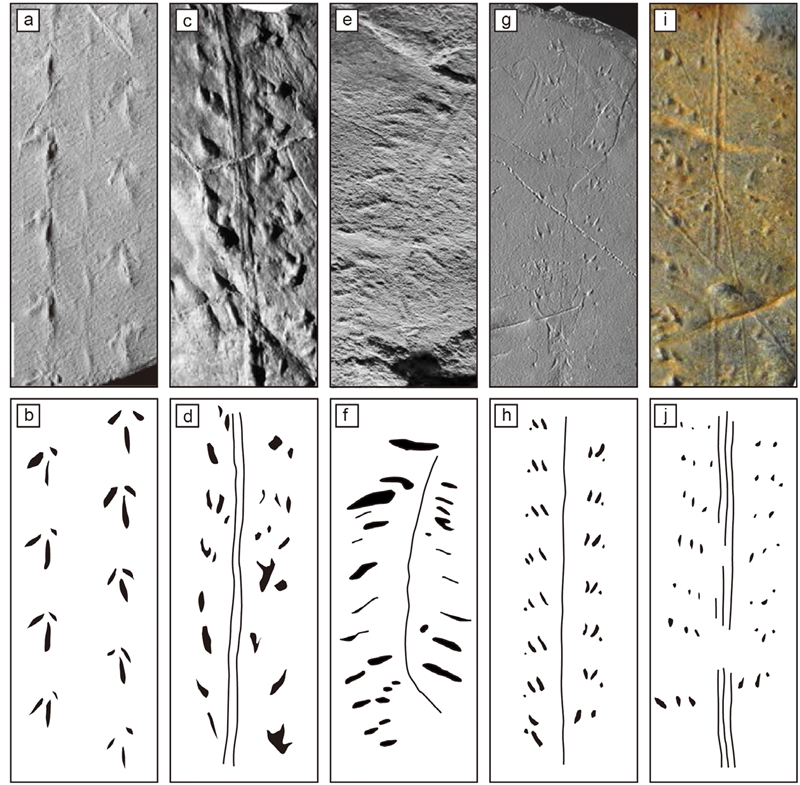
Trackways of the insects. (a) Lithographus hieroglyphicus (modified from Minter and Braddy, 2009). (b) Interpretive drawing of L. hieroglyphicus. (c) Siskemia elegans (modified from Getty et al., 2013). (d) Interpretive drawing of S. elegans. (e) Stiallia pilosa (modified from Getty et al., 2013). (f) Interpretive drawing of S. pilosa. (g) Stiaria intermedia (modified from Minter and Braddy, 2006). (h) Interpretive drawing of S. intermedia. (i) Mitchellichnus ferrydenensis (modified from Getty et al., 2017). (j) Interpretive drawing of M. ferrydenensis.
일반적으로 곤충에 의해 만들어졌을 것으로 추정되는 보행흔은 세 쌍의 족흔이 하나의 세트를 구성하여 나타난다. 이는 세 쌍의 다리를 이용하여 보행한다는 곤충의 특징에 기반을 둔 것이며 현생생흔학 연구도 이를 뒷받침한다(Davis et al., 2007; Minter et al., 2007b; Getty et al., 2013). 또한, 곤충 중 유일하게 보행할 때 좌우 대칭의 움직임을 보이는 archaeognathans를 제외한 곤충들은 양쪽 보행의 움직임이 비대칭을 이루고 있으므로(Manton, 1977) archaeognathans에 의해 만들어졌을 것으로 추정되는 중앙선을 기준으로 대칭의 족흔을 보이는 Stiaria intermedia (Getty et al., 2017)를 제외한 곤충의 보행렬은 중앙선을 기준으로 비대칭을 이룬다.
우항리층의 L. hieroglypicus는 서로 다른 방향의 세 쌍의 족흔이 세트를 이루며 반복된다는 점과 중앙선(mid-line)을 중심으로 양쪽이 엇갈리거나(staggered) 번갈아가며(alternating) 나타난다는 점에서 곤충의 보행렬의 특징과 매우 유사하다. 휴식흔에서 관찰되는 마디가 관찰되는 중심부 타원형 인상(medial oval imprint)은 곤충의 배(abdomen)와 유사하며 중심부 원형 인상(medial circular imprint)은 가슴(thorax)에 의한 흔적으로 보이며 이는 곤충의 형태와 매우 유사하다(그림 7a, 7b). 절지동물 생흔화석의 형태적인 정보와 한반도 백악기 퇴적층에서 보고된 곤충화석들을 비교하였을 때 잠자리(Odonata) 유충이 가장 생흔형성자에 유사하다.
6. 논의 및 결론
해남분지 후기백악기 우항리층의 화학적 침전으로 생성된 처트질이암층 상부에서 절지동물 보행흔 Lithographus hieroglypichus와 함께 버로우, 휴식흔이 관찰된다. 절지동물 생흔화석들은 서로 연결되어 있거나 매우 인접하기 때문에 같은 생흔형성자에 의해 만들어졌을 것으로 판단된다. 정교한 형태의 절지동물의 보행렬은 과거 호수 주변부의 수분에 포화된 세립질 퇴적물이 안정화 된 상태에서 보존된 것으로 보이며 처트질이암의 전구물질인 비정형의 실리카 침전물이 가지고 있는 점성과 위에 덮여 있는 응회질의 퇴적물이 보행렬의 보존에 영향을 미친 것으로 보인다. 우항리층의 L. hieroglypichus의 다양한 형태적인 변이를 통하여 과거 절지동물이 생흔을 만들었을 시기에 생흔이 남겨진 퇴적물이 공기중에 노출되어 수분 변화가 일어났던 것으로 해석되며, 이 생흔들이 새 발자국 화석과 함께 산출된다는 점, 시네레시스 균열은 관찰되지만 건열은 관찰되지 않는다는 점이 이를 뒷받침한다.
우항리층 절지동물 생흔화석을 전 세계에서 보고된 다른 절지동물 생흔화석들과의 비교 결과, 세 쌍의 족흔이 반복되는 좌우 비대칭적인 보행렬과 중앙의 끌린 흔적, 휴식흔에서 보이는 간접적인 생흔형성자의 형태적 특징을 바탕으로 우항리층의 절지동물 생흔형성자는 곤충 가운데 잠자리 유충일 것으로 판단된다. 잠자리 유충은 성충과 마찬가지로 세 쌍의 다리를 가지고 있으며 날개를 이용하여 날아다니는 성충과는 다르게 다리를 이용하여 생활하므로 많은 생흔을 남겼을 가능성이 있다. Metz (2002)는 현생의 잠자리 유충이 만드는 보행렬의 형태와 Protovirgularia의 형태적인 유사점과, Protovirgularia가 비해성 환경인 경상분지 진주층에서 보고되었다는 점(Kim et al., 2000)을 통하여 트라이아스기 이후의 비해성퇴적층에서 발견되는 Protovirgularia가 잠자리 유충에 의하여 만들어졌을 가능성을 제시하였다. 우항리층 절지동물 보행렬 중 셰브론 무늬의 중앙의 끌린 흔적이 나타나는 L. hieroglypichus는 전기백악기 진주층에서 발견된 Protovirgularia와 중앙의 끌린 흔적의 형태에서 유사성을 보이지만 반복되는 족흔 쌍의 형태나 개수에 있어서 차이가 있다. 그러나 진주층의 Protovirgularia는 세립질 사암의 표면에서 발견되고(Kim et al., 2000), 우항리층의 L. hieroglypichus는 처트질이암의 표면에서 발견된다는 점을 고려한다면 같은 생흔형성자에 의한 생흔이더라도 퇴적물의 입자 크기나 수분에 의하여 형태가 다른 생흔이 만들 수 있기 때문에(Davis et al., 2007) 두 보행렬 모두 잠자리 유충에 의해 만들어졌을 가능성이 있다.
한반도에서 우항리층과 같은 시대인 후기백악기의 잠자리 화석이 아직 보고된 바가 없긴 하지만 전기백악기에 잠자리가 이미 북한지역부터 남한지역에 이르기까지 넓은 지역에서 보고되었고 현재까지도 전 지역에서 번영하고 있는 것을 보아 후기백악기인 우항리층에도 잠자리가 충분히 서식하고 있을 수 있었을 것으로 보인다. 잠자리 대부분은 유충 시절 수서환경에서 저서 생활을 하지만 조건에 따라 공기 중에 노출된 환경에서도 활동하기도 한다. 이는 공기 중에 노출되었지만 수분에 포화된 퇴적물에 파고 들었던 우항리층 절지동물 생흔화석의 생성자의 생태와 일치한다. Uropetala와 같은 현생의 잠자리 유충들 또한 버로우를 만드는 것으로 알려져 있고(Wolfe, 1957) 이러한 행동양식이 화석으로 기록되어 있을 수 있다는 가능성이 제시된 바 있다(Fitzgerald and Barrett, 1986). 이는 얕은 깊이로 자신의 몸을 숨길 수 있을 정도로만 파고들었던 우항리층 절지동물 생흔형성자의 특징과 일치한다.
Acknowledgments
이 연구는 한국연구재단 기초연구사업(NRF-2016R1D1A1A099182)의 지원을 받아 수행되었다. 연구 대상인 절지동물 생흔화석 조사에 협조해주신 해남공룡박물관, 표본 촬영에 큰 도움과 조언해주신 공주교육대학교 남기수 교수님, 논문 작성에 도움을 주신 전남대학교 지오컨버전스센터 윤연흠 박사님, 학부논문조로 현장조사 및 자료정리에 함께해준 한국철도공사 강민구에게 고마움을 전한다. 마지막으로 이 논문의 심사과정에서 발전적인 비평과 도움을 주신 부경대학교 백인성 교수님과 익명의 심사위원님들에게 감사를 표합니다.
References
- Baek, K.S. and Yang, S.Y., 2004, Cockroaches from the early Cretaceous of Korea. Journal of the paleontological Society of Korea, 20, 71-98 (in Korean).
- Bandel, K., 1967, Isopod and Limulid Marks and Trails in Tonganoxie sandstone (Upper Pennsylvanian) of Kansas. The University of Kansas Paleontological Contributions, 1-19.
-
Braddy, S.J., 2001, Trackways-arthropod locomotion. In: Briggs, D.E.G. and Crowther, P.R. (eds.), Palaeobiology II. Blackwell Science, London, 389-393.
[https://doi.org/10.1002/9780470999295.ch92]

- Brady, S.F., 1939, Tracks in the Coconino Sandstone compared with those of small living arthropods. Plateau, 12, 32-34.
-
Buatois, L.A., Mangano, M.G., Maples, C.G. and Lanier, W.P., 1998, Ichnology of an upper Carboniferous Fluvio-Estuarine Paleovalley: The Tonganoxie sandstone, Buildex Quarry, Eastern Kansas, USA. Journal of Paleontology, 72, 152-180.
[https://doi.org/10.1017/S0022336000024094]

-
Burst, J.F., 1965, Subaqueously formed shrinkage cracks in clay. Journal of Sedimentary Petrology, 35, 348-353.
[https://doi.org/10.1306/74D71271-2B21-11D7-8648000102C1865D]

-
Choi, B.D. and Huh, M., 2016, Mongolocypris kohi sp. nov.: A new Early Cretaceous non-marine ostracod species from the Jinju Formation, South Korea. Cretaceous Research, 57, 239-247.
[https://doi.org/10.1016/j.cretres.2015.09.008]

-
Choi, B.D., Jugdernamjil, M., Huh, M. and Yondon, K., 2017, Study on the Cretaceous non-marine ostracods from the Hampyeong Basin. Journal of the Geological Society of Korea, 53, 631-643 (in Korean with English abstract).
[https://doi.org/10.14770/jgsk.2017.53.5.631]

-
Choi, B.D., Wang, Y.Q. and Huh, M., 2018, Cypridea species (Crustacea, Ostracoda) from the Lower Cretaceous Jinju Formation of the Gyeongsang Basin, South Korea. Palaeoworld, 27, 382-391.
[https://doi.org/10.1016/j.palwor.2018.03.005]

- Choi, S.J., 1990, Some nonmarine fossils from the central part of Gyeongsang Basin, S. Korea. Journal of the paleontological Society of Korea, 6, 165-179 (in Korean with English abstract).
-
Chough, S.K., Kim, S.B. and Chun, S.S., 1996, Sandstone/chert and laminated chert/black shale couplets, Cretaceous Uhangri Formation (southwest Korea): depositional events in alkaline lake environments. Sedimentary Geology, 104, 227-242.
[https://doi.org/10.1016/0037-0738(95)00130-1]

-
Chun, S.S. and Chough, S.K., 1992, Depositional sequences from high-concentration turbidity currents, Cretaceous Uhangri Formation (SW Korea). Sedimentary Geology, 77, 225-233.
[https://doi.org/10.1016/0037-0738(92)90128-E]

-
Chun, S.S. and Chough, S.K., 1995, The Cretaceous Uhangri Formation, SW Korea: lacustrine margin facies. Sedimentology, 42, 239-322.
[https://doi.org/10.1111/j.1365-3091.1995.tb02104.x]

-
Davis, R.B., Minter, N.J. and Braddy, S.J., 2007, The neoichnology of terrestrial arthropods. Palaeogeography, Palaeoclimatology, Palaeoecology, 255, 284-307.
[https://doi.org/10.1016/j.palaeo.2007.07.013]

- Dindal, D.L., 1990, Soil Biology Guide: John Wiley and Sons, New York, 1349 p.
-
Engel, M.S., Lim, J.D. and Baek, K.S., 2006, Fossil snakeflies from the Early Cretaceous of southern Korea (Raphidioptera: Mesoraphidiidae). Neues Jahrbuch für Geologie und Paläontologie-Monatshefte, 4, 249-256.
[https://doi.org/10.1127/njgpm/2006/2006/249]

- Engel, M.S., Lim, J.D., Baek, K.S. and Martin, L.D., 2002, An Earwig from the Lower Cretaceous of Korea (Dermaptera: Forflculina). Journal of the Kansas Entomological Society, 75, 86-90.
-
Fairchild, J.M. and Hasiotis, S.T., 2011, Terrestrial and Aquatic neoichnological laboratory experiments with the freshwater crayfish Orconectes: Trackways on media of varying grain size moisture, and inclination. Palaios, 26, 790-804.
[https://doi.org/10.2110/palo.2011.p11-066r]

-
Fitzgerald, P.G. and Barrett, P.J., 1986, Skolithos in a Permian braided river deposit, southern Victoria Land, Antarctica. Palaeogeography, Palaeoclimatology, Palaeoecology, 52, 237-247.
[https://doi.org/10.1016/0031-0182(86)90049-0]

-
Fortey, R.A. and Seilacher, A., 1997, The trace fossil Cruziana serniplicata and the trilobite that made it. Lethaia, 30, 105-112.
[https://doi.org/10.1111/j.1502-3931.1997.tb00450.x]

-
Gaillard, C., Hantzpergue, P., Vannier, J., Margerard, A.L. and Mazin, J.M., 2005, Isopod trackways from the Crayssac Lagerstatte, Upper Jurassic, France. Palaeontology, 48, 947-962.
[https://doi.org/10.1111/j.1475-4983.2005.00502.x]

-
Getty, P.R., Sproule, R., Stimson, M.R. and Lyons, P.C., 2017, Invertebrate trace fossils from the Pennsylvanian Rhode Island Formation of Massachusetts, USA. Atlantic Geology, 53, 185-206.
[https://doi.org/10.4138/atlgeol.2017.007]

-
Getty, P.R., Sproule, R., Wagner, D.L. and Bush, A.M., 2013, Variation in wingless insect trace fossils: insights from neoichnology and the Pennsylvanian of Massachusetts. Palaios, 28, 243-258.
[https://doi.org/10.2110/palo.2012.p12-108r]

-
Gibbard, P.L. and Dreimanis, A., 1978, Trace fossils from late Pleistocene glacial lake sediments in southwestern Ontario, Canada. Canadian journal of earth sciences, 15, 1967-1976.
[https://doi.org/10.1139/e78-207]

-
Hasiotis, S.T., 2000, The invertebrate invasion and evolution of Mesozoic soil ecosystems: The ichnofossil record of ecological innovations. In: Gastaldo, R. and Dimichele, W. (eds.), Phanerozoic Terrestrial Ecosystems, Paleontological Society Short Course Number, 6, 141-169.
[https://doi.org/10.1017/S1089332600000747]

-
Hasiotis, S.T., 2004, Reconnaissance of Upper Jurassic Morrison Formation ichnofossils, Rocky Mountain Region, USA: paleoenvironmental, stratigraphic, and paleoclimatic significance of terrestrial and freshwater ichnocoenoses. Sedimentary Geology, 167, 177-268.
[https://doi.org/10.1016/j.sedgeo.2004.01.006]

-
Hasiotis, S.T., 2007, Continental ichnology: fundamental processes and controls on trace fossil distribution. In: Miller III, W. (eds.), Trace Fossils, Elsevier, 268-284.
[https://doi.org/10.1016/B978-044452949-7/50142-X]

-
Hembree, D.I., 2013, Neoichnology of the whip scorpion Mastigoproctus Giganteus: Complex burrows of predatory terrestrial arthropods. Palaios, 28, 141-162.
[https://doi.org/10.2110/palo.2012.p12-079r]

- Hitchcock, E., 1858, Ichnology of New England: A Report on the Sandstone of the Connecticut Valley Especially Its Fossil Footmarks. W. White, Boston.
- Huh, M. and Chung, C.H., 2009, A report on fossil beetles (Insecta: Coleoptera) from the Cretaceous deposits in the Hampyeong Basin, Korea. Journal of the Geological Society of Korea, 45, 275-281 (in Korean with English abstract).
- Huh, M., Lee, Y.N., Lim, S.K. and Hwang, K.-G., 1998, Research Report on the Haenam Dinosaur Site, Korea. Chonnam National University Museum, Chonnam-do, Haenam-gun, 499 p (in Korean).
- Hwang, K.G., 2001, Dinosaur and Pterosaur Tracks from the Late Cretaceous Uhangri Formation, Haenam, SW Korea. Ph.D. thesis, Chonnam National University, Gwangju, 182 p.
-
Hwang, K.G., Huh, M., Lockley, M.G., Unwin, D.M. and Wright, J.L., 2002, New pterosaur tracks (Pteraichnidae) from the Late Cretaceous Uhangri Formation, southwestern Korea. Geological Magazine, 139, 421-435.
[https://doi.org/10.1017/S0016756802006647]

-
Hwang, K.G., Lockley, M.G., Huh, M. and Paik, I.S., 2008, A reinterpretation of dinosaur footprints with internal ridges from the Upper Cretaceous Uhangri Formation, Korea. Palaeogeography, Palaeoclimatology, Palaeoecology, 258, 59-70.
[https://doi.org/10.1016/j.palaeo.2007.10.029]

-
Jon, S.H., So, K.S., Won, C.G. and Hyon, L.J., 2020, A new species of Procercopidae (Insecta: Hemiptera) from the Lower Cretaceous of Democratic People's Republic of Korea. Cretaceous Research, 108, 104353.
[https://doi.org/10.1016/j.cretres.2019.104353]

-
Jon, S.H., Won, C.G., So, K.S. and Nam, T.Y., 2019, New Mesozoic insect fossils from the Democratic People's Republic of Korea. Cretaceous Research, 99, 240-245.
[https://doi.org/10.1016/j.cretres.2019.02.019]

-
Khramov, A.V., Nam, G.S. and Vasilenko, D.V., 2019, First long-proboscid flies (Diptera: Zhangsolvidae) from the Lower Cretaceous of South Korea. Alcheringa: An Australasian Journal of Palaeontology, 1-9.
[https://doi.org/10.1080/03115518.2019.1664634]

-
Kim, C.B., Huh, M., Cheong, C.S., Lockley, M.G. and Chang, H.W., 2003, Age of the pterosaur and web-footed bird tracks associated with dinosaur footprints from South Korea. The Island Arc, 12, 125-131.
[https://doi.org/10.1046/j.1440-1738.2003.00385.x]

- Kim, J.Y., Kim, K.S. and Pickerill, R.K., 2000, Trace Fossil Protovirgularia McCoy, 1850 from the Nonmarine Cretaceous Jinju Formation of the Sacheon area, Korea. Journal of Korean Earth Science Society, 21, 695-702.
- Kim, S.T., Han, N.K., Yoon, H.B., Jeon, B.C., Park, J.N., Lim, K.H., Park, I.S., Lee, J.I. and Choi, J.H., 1992, The Fossils of Chosen 2. Science Engineering Press, Pyongyang, 112 p (in Korean).
- Lee, D.S. and Lee, H.Y., 1976, Geological and geochemical study on the rock sequence containing oil materials in southwestern coast area of Korea. Journal of the Korean Institute of Mining Geology, 23, 135-141 (in Korean with English abstract).
-
Lee, Y.N. and Huh, M., 2002, Manus-only sauropod tracks in the Uhangri formation (Upper Cretaceous), Korea and their paleobiological implications. Journal of Paleontology, 76, 558-564.
[https://doi.org/10.1666/0022-3360(2002)076<0558:MOSTIT>2.0.CO;2]

- Lockley, M.G., Huh, M., Lim, S.-K., Yang, S.-T. and Unwin, D., 1997, First report of pterosaur tracks from Asia, Chollanam Province Korea. Journal of the Paleontological Society of Korea, Special Publication, 2, 17-32.
- Manton, S.M., 1977, The Arthropoda. Habits, functional morphology and evolution. Clarendon Press, Oxford.
-
Metz, R., 2002, Nonmarine Cretaceous Protovirgularia: Possible Dragonfly Larva Tracemaker. Ichnos, 9, 75-76.
[https://doi.org/10.1080/10420940216417]

-
Minter, N.J. and Braddy, S.J., 2006, Walking and jumping with Palaeozoic Apterygote insects. Palaeontology, 49, 827-835.
[https://doi.org/10.1111/j.1475-4983.2006.00571.x]

- Minter, N.J. and Braddy, S.J., 2009, Ichnology of an Early Permian intertidal flat: the Robledo mountains formation of southern New Mexico, USA. Special papers in Palaeontology, 82, 20-28.
-
Minter, N.J., Braddy, S.J. and Davis, R.B., 2007a, Between a rock and a hard place: arthropod trackways and ichnotaxonomy. Lethaia, 40, 365-375.
[https://doi.org/10.1111/j.1502-3931.2007.00035.x]

-
Minter, N.J., Krainer, K., Lucas, S.G., Braddy, S.J. and Hunt, A.P., 2007b, Palaeoecology of an Early Permian playa lake trace fossil assemblage from Castle Peak, Texas, USA. Palaeogeography, Palaeoclimatology, Palaeoecology, 246, 390-423.
[https://doi.org/10.1016/j.palaeo.2006.10.009]

-
Minter, N.J., Lockley, M.G., Huh, M., Hwang, K.G. and Kim, J.Y., 2012, Lithographus, an Abundant Arthropod Trackway from the Cretaceous Haenam Tracksite of Korea. Ichnos, 19, 115-120.
[https://doi.org/10.1080/10420940.2011.625756]

- Moon, H.-S., Kim, Y.-H., Kim, J.-H. and You, J.-H, 1990, K-Ar ages of alunite and sericite in altered rocks, and volcanic rocks around the Haenam area, southwest Korea. Journal of the Korean Institute of Mining Geology, 23, 135-141 (in Korean with English abstract).
-
Nam, K.S. and Kim, J.H., 2016, Reconstruction and Paleoecological implications of Dragonfly Hemeroscopus baissicus Pritykina, 1977 (Hemeroscopidae) from the Lower Cretaceous Jinju Formation in the Jinju Area, Korea. Journal of the Geological Society of Korea, 52, 105-112 (in Korean with English abstract).
[https://doi.org/10.14770/jgsk.2016.52.2.105]

- Paik, K.H., Kim, Y.K. and Huh, M., 1988, Ostracodes from the Chinju Formation (Cretaceous, Non-marine) in Kyongsang Basin, Korea. Journal of the paleontological Society of Korea, 4, 94-109.
-
Park, T.Y., Wilson, G.D., Lee, D.C. and Choi, D.K., 2012, Occurrence of the isopod Archaeoniscus Coreaensis new species from the Lower Cretaceous Jinju Formation, Korea. Journal of Paleontology, 86, 626-640.
[https://doi.org/10.1666/11-131R.1]

- Park, T.Y.S., Kim, Y.H. and Nam, K.S., 2013, Preliminary research on the aquatic coleopteran, Coptoclava from the Early Cretaceous Jinju Formation. Journal of the Geological Society of Korea, 49, 617-624 (in Korean with English abstract).
-
Park, T.Y.S., Nam, K.S. and Selden, P.A., 2019, A diverse new spider (Araneae) fauna from the Jinju Formation, Cretaceous (Albian) of Korea. Journal of Systematic Palaeontology, 1-27.
[https://doi.org/10.1080/14772019.2018.1525441]

-
Pirrie, D., Feldmann, R.M. and Buatois, L.A., 2004, A new decapod trackway from the Upper Cretaceous, James Ross Island, Antarctica. Palaeontology, 47, 1-12.
[https://doi.org/10.1111/j.0031-0239.2004.00343.x]

-
Sadler, C.J., 1993, Arthropod trace fossils from the Permian de Chelly Sandstone, Northeastern Arizona. Journal of Paleontology, 76, 240-249.
[https://doi.org/10.1017/S0022336000032169]

-
Schmerge, J.D., Riese, D.J. and Hasiotis, S.T., 2013, Vinegaroon (Arachnida: Thelyphonida: Thelyphonidae) trackway production and morphology: Implications for media and moisture control on trackway morphology and a proposal for a novel system of interpreting arthropod trace fossils. Palaios, 28, 116-128.
[https://doi.org/10.2110/palo.2012.p12-012r]

-
Selden, P.A., Nam, K.S., Kim, S.H. and Kim, H.J., 2012, A fossil spider from the Cretaceous of Korea. Journal of Paleontology, 86, 1-6.
[https://doi.org/10.1666/11-094.1]

-
So, K.S., Won, C.G., Han, K.S., Xu, C., Wang, B. and Fang, Y., 2020, The first Orthoptera (Insecta) from the Lower Cretaceous of Democratic People's Republic of Korea. Cretaceous Research, 108, 104336.
[https://doi.org/10.1016/j.cretres.2019.104336]

-
Sohn, J.C., Nam, G.S., Choi, S.W. and Ren, D., 2019, New fossils of Elateridae (Insecta, Coleoptera) from Early Cretaceous Jinju Formation (South Korea) with their implications to evolutionary diversity of extinct Protagrypninae. PLOS One, 14, 1-12.
[https://doi.org/10.1371/journal.pone.0225502]

-
Tetlie, O.E. and Dunlop, J.A., 2008, Geralinura Carbonaria (Arachnida; Uropygi) from Mazon Creek, Illinois, USA, and the Origin of Subchelate Pedipalps in Whip Scorpions. Journal of Paleontology, 82, 299-312.
[https://doi.org/10.1666/06-138.1]

- Trewin, N.H., 1994, A Draft system for the identification and description of arthropod trackways. Palaeontology, 37, 811-823.
- Ueda, K., Kim, T.W. and Aoki, T., 2005, A new record of Early Cretaceous fossil dragonfly from Korea. Bulletin Kitakyushu Museum of Natural History (series A), 3, 145-152.
-
Walker, S.E., Holland, S.M. and Gardiner, L., 2003, Coenobichnus Currani (New Ichnogenus and Ichnospecies): Fossil trackway of a land hermit crab, Early Holocene, San Salvador, Bahamas. Journal of Paleontology, 77, 576-582.
[https://doi.org/10.1666/0022-3360(2003)077<0576:CCNIAI>2.0.CO;2]

- Wallwork, J.A., 1970, Ecology of Soil Animals. McGraw-Hill, London, 283 p.
-
White, W.A., 1961, Colloid phenomena in Sedimentation of Argillaceous Rocks. Journal of Sedimentary Petrology, 31, 560-570.
[https://doi.org/10.1306/74D70BE6-2B21-11D7-8648000102C1865D]

- Wolfe, L.S., 1957, A study of the genus Uropetala Selys (Order Odonata) From New Zealand. Transactions of the Royal Society of New Zealand, 80, 245-275
-
Yang, S.Y., Lockley, M.G., Greben, R., Erickson, B.R. and Lim, S.K.,1995, Flamingo and duck-like bird tracks from the Late Cretaceous and Early Tertiary: evidence and implications. Ichnos, 4, 21-34.
[https://doi.org/10.1080/10420949509380111]



